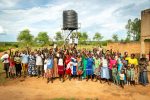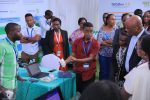Building human and institutional bridges for success: Evidence from a national approach to transformative education in Cameroon

1Cheo Emmanuel Suh, 2Pride Ndasi Ngwasiri, 3Victor Ngu Cheo & Anthony Egeru4
- TAGDev 2.0 Program Coordinator and Deputy Vice Chancellor-Teaching, Professionalization and Development of Information and Communication Technology, University of Bamenda, Cameroon
- TAGDev 2.0 Associate Program Officer, Head, Department of Nutrition, Food and Bioresource Technology, University of Bamenda, Cameroon
- TAGDev 2.0 Communication Officer, Director of Academic Affairs, The University of Bamenda, Cameroon
- Program Manager-Skilling and Engagement for Community Development, RUFORUM Secretariat, Uganda
TAGDev 2.0 Think Tank Series Paper #2
Introduction
Human capital—the skills, knowledge, and capabilities embodied in people—is a core driver of productivity and innovation. Why does this matter for higher education? In higher education, collaborative arrangements between government agencies and university networks can accelerate human-capital formation by aligning curricula, research, training, and work-based learning with national development priorities. In Cameroon, the National Development Strategy (NDS30) places the onus of building human capital on the universities. The NDS30 strategy seeks to structurally transform the economy by improving human capital through better education, health, and skills training. This national strategy further aligns with the aspirations of Central African Economic and Monetary Community (CEMAC) region’s human capital enhancement endeavor.
For universities in Cameroon and Central African Economic and Monetary Community (CEMAC) to train requisite generation of innovators and development drivers, HEIs ought to build bridges with other ministerial departments, national research, innovation and service providers, actors of the agrifood system, national development agencies, private higher education institutions (PHEIs) and industrial partners by defining a transformative education agenda that is in alignment with the development strategies. This contribution presents the windfalls derived from such ‘crossing the borders’ or ‘building the bridges’ approaches by the University of Bamenda within the framework of the Transforming Africa’s Agricultural Universities to Meaningfully Contribute to Africa’s Growth and Development (TAGDev 2.0) program. This builds on the early engagement from TAGDev 1.0 in which University of Bamenda piloted the transformation of its curricula into competence based oriented curricula in one of its faculties. In this article, we explore how the approach at University of Bamenda relates to core frameworks on which such collaboratives can be anchored. Frameworks such as the Triple Helix (Etzkowitz & Leydesdorff, 2000, Leydesdorff, 2012) of university–industry–government relations and Mode 2 knowledge production (Gibbons et al., 1994) explain why cross-sector collaboration tends to produce more applied, socially robust skills and research than siloed approaches. These frameworks are exemplified through TAGDev 2,0 actions at University of Bamenda as demonstrated here.
Core frameworks with government agencies
One of the pillars of transformative education at University of Bamenda is to create national impact and policy influence through meaningful teaching, research and community engagement. Accordingly, the University evolved a strategic approach focused on internal institutional reform learning for scaling-up and scaling out to other higher education institutions and engagement with Ministries, Departments and Agencies (MDAs) of government (Figure 1). In doing this, the University of Bamenda recognized that universities, industry, and government are overlapping spheres that co-produce knowledge, skills, and innovation. To progress with this, University of Bamenda must periodically evaluate itself against national metrics and align with the vision of the state. As a public university, University of Bamenda adheres to the dictates of regulations governing higher education development in Cameroon monitored by the Ministry of Higher education (MINESUP). The University annually subjects itself to an auto-evaluation exercise using an evaluation instrument aligned to that of the Ministry and the African Quality rating Mechanism. The TAGDev 2.0 Monitoring, Evaluation and Learning (MEL) team is playing a significant role in advancing the monitoring and learnings from this evaluation. The net result has been increased interest in the performance of the university by the Ministry and by extension, easing access to resources. An example is the University Digital Development Centre (UDDC) which is an ultramodern facility for preparing and delivering online content. University of Bamenda has an institutional learning management system (LMS) to increase access to erstwhile underserved populations especially internally displaced persons. The UDDC facility is amongst the few fully functional in the country thanks to the unreserved support from the Ministry of Higher Education which obviously noted University of Bamenda’s drive towards e-learning and the evaluation work done on its LMS.

Figure 1: University of Bamenda internal institutional and outward facing engagement approach
The University has also established a signed collaboration framework with the Ministry of Agriculture and Rural Development (MINADER). This has allowed for the Regional College of Agriculture in Bamenda and the North West Cooperatives Association and other farmer groups to participate in designing joint programs, internships, and research areas that explicitly develop talent and resolve pressing national issues of food systems. The review of the curriculum in certain agriculture disciplines in the College of Technology (COLTECH) with support from RUFORUM, had inputs and focused group discussions with these agencies and associations. Also, the training of seed producers and community advisory and extension workers in November 2025 by University of Bamenda through the TAGDev 2.0 Program engaged easily with MINADER actors to carry out the needs assessment and involve students on the field with well-defined problems to solve and assured of access to existing data and farmer networks. This same bridge is being leveraged to develop and deploy the technologies, innovations and management practices (TIMPs).
The University of Bamenda is also focused on student development especially soft skills acquisition including leadership capabilities. In Cameroon the youth development program termed the national civic education and moral rearmament scheme is lodged in the Ministry of Youth Affairs and Civic Education (MINJEC). The country’s Youth Triennial Plan funded with over 1.5 billion XAF is placed under MINJEC which also operates a number of youth business incubation centres across the country. To enable our students buy into these resources, University of Bamenda through direct engagement of the Vice-Chancellor with the Minister, undertook the development of a training program in leadership, civic responsibility and sustainable development. TAGDev 2.0 ran a two-days workshop with MINJEC high level management and established a new training program in this domain that is aimed to become a national course of training for tertiary institutions. This course is compulsory for all students at University of Bamenda and its PHEI partners and was successfully launched in October 2025 with the first cohort of over 11,000 students taking it in the 2025/2026 academic year. Why does this matter:
- An MoU has been established between University of Bamenda and MINJEC to assist TAGDev 2.0 access all its entrepreneurship centres across the country. This is beneficial especially for the out-of-school youth skilling plan.
- MINESUP and MINJEC launched a joint call for 5000 student enterprises to be supported by public funds. Eight students at University of Ngaoundéré (partner institution to University of Bamenda in TAGDev 2.0) have so far been successful with this call and shall continue to be coached and supported.
- Students who complete the leadership course and inscribe themselves on the MINJEC digital database would have completed moral rearmament training and therefore qualify for consideration within the Youth Triennial plan for funding to support enterprises.
- MINJEC staff are involved in business coaching for out-of-school youths as well as university students which aligns with our activities.
The third axis that illustrates engagement with government is the support the University of Bamenda Technology, Innovation and Incubation Centre (University of Bamenda-TIIC) receives. Two ministerial departments: the Ministry of Mines, Industry and Technological Development and the Ministry of Small and Medium-sized Enterprises, Social Economy, and Handicraft have provided financial and technical support to the growth of University of Bamenda-TIIC. Over the past two years over 200 million XAF has been provided to incubation processes at University of Bamenda through COLTECH and University of Bamenda’s school of engineering, NAHPI. The outcome: students have developed projects that have won prizes at the Cameroon Student Talent Search (GETEC) which is a national competition of student entrepreneurs. Indeed in 2024 University of Bamenda came second across the country for its student start-ups at the GETEC. The Youth Empowerment Program in Cameroon (SOAP) held in Yaoundé in September 2025 under MINESUP’s supervision, with the participation of the University of Bamenda and its TAGDev. 2.0 Program. The SOAP reached out to 388 youths who are currently being supported on agricultural training in Cameroon and opportunities offered. The Minister of State, Minister of Higher Education visited the exhibition and buoyed by Prime Minister’s symbolic planting of the first tree to launch the tree planting plan at University of Bamenda campus, the program continued to receive national limelight.
These examples demonstrate how networks involving universities, government agencies and partner firms can convert external knowledge into capability—implying that repeated, structured collaboration increases students’ and institutions’ ability to learn and benefit from partners; the so-called absorptive capacity framework (Cohen & Levinthal, 1990). They also emphasize that transdisciplinary, problem-focused, networked research and training often yield competencies directly relevant to societal and economic problems. This is TAGDev 2.0 in action!
Core frameworks with private higher education institutions (PHEIs)
The University of Bamenda at the moment has 55 PHEIs under its mentorship and the number is still increasing. Students trained at these PHEIs are certified by University of Bamenda and there are strict protocols governing teaching, learning, examinations and internships as well as monitoring by University of Bamenda. The PHEIs by their design allow micro-credential stacks and short modules stackable into degrees and coordinated nationally to ease recognition and employer uptake. This contributes to lifelong learning through bridging programs. Both staff and students at these PHEIs benefit from the opportunities that University of Bamenda and the TAGDev 2.0 Program avail. In the course of this year eleven (11) of these PHEIs have taken up agriculture and a number of curricula are under review jointly with the consultants hired by RUFORUM through the TAGDev 2.0 Program. The increasing interest in agriculture and allied disciplines at these PHEIs is thanks to a number of activities recently carried out through TAGDev 2.0 aimed at institutional strengthening. These include:
- Onboarding and capacity building workshops with PHEIs. These were organized in Bamenda (134 participants, 55 females, 79 males and 3 differently abled persons), Yaoundé (82 participants, 28 females and 54 males} and Buea (172 participants, 80 females, 92 males) and involved managers and teaching staff representatives. These workshops focused on aspects of inclusion, student development and agriculture as a principal domain for Africa’s growth and development
- Training on incubation hub management and business creation organized with PHEIs in Bamenda and Yaoundé with 57 participants (39 males and 18 females) and 62 participants (39 males and 23 females), respectively. These trainings benefitted from support provided by the core team at the RUFORUM Secretariat online.
- Training on Transformative education, content delivery in a course credit system, and experiential learning organized in Bamenda with 87 participants (45 males and 42 females), Yaoundé with 41 participants (25 males and 16 females), and specific session for Catholic University of Cameroon (CATUC) with 96 participants (62 males and 37 females) including VC, DVCs and Directors. CATUC is a key partner to University of Bamenda on developing the problem-based learning (PBL) community project approach.
- Delivery of orientation modules to students at these PHEIs that is progressing.
- Engaging with TVETs and their staff capacity development notably with the Cameroon Opportunities Industrialization Centre (COIC) and the Horticulture Institute in Buea where the first field greenhouse of TAGDev 2.0 is being co-established and has 5 female IDPs undergoing training on propagation techniques. The students of agriculture at the COIC and other youth led groups in horticulture will constantly receive training and skilling at this site.
One of the PHEIs which also has a TVET training pipeline is the Obala Higher Institute of Economics and Management (ISAGO). ISAGO has a registered incubation unit that processes and bottles juice from fruits produced by their students on their estate farms. It integrates crops with animal husbandry and has a community support program for out-of-school youth enterprise creation and a cooperative. University of Bamenda’s collaboration with ISAGO has created synergy and assisted other PHEIs to ensure that entrepreneurship education gets the focus it deserves. ISAGO as a success story was celebrated nationally in 2023 and it is an implementing partner with University of Bamenda on the TAGDev 2.0 program mainly in the incubation aspects.
Working with University of Bamenda’s PHEIs we have succeeded in co-designing curricula, micro-credentials accreditation and engagements with agencies and employers to close skills gaps. The rise of national micro-credential ecosystems is championed in this way and aligns higher education training with labor-market needs. We are also pooling these universities, firms, and agencies around targeted domains; typically including industry placements, and transferable-skills training. University of Bamenda is collaborating with the PHEIs to build lifelong learning compacts that integrate universities into the national skills ecosystem similar to the Skills Future Singapore program which demonstrated public demand and funding for continuous upskilling delivered through HEI networks.
What does our evidence demonstrate for higher education institutions?
Building on the lessons from the pilot in TAGDev 1.0 and the scaling up and out in TAGDev 2.0 the program provides the following key lessons and takeaways for the higher education institutions and ecosystem for facilitating the building of bridges:
- Through university partnerships and training centers that tackle national shortages, skills for future workforce development are developed and those in the market can radically be enhanced to become viable in the labour market.
- Student industry placement and collaboration facilitate short-turn around for evidence provision of impact through clear provision of value of investment as well as return on investment through entrepreneurship and business creation pathways.
- Engagement with Ministries, Departments and Agencies (MDAs) of government is catalytic in accelerating scaling out of innovations for human capital development because government has the power to cause real transformative change through it’s internal to outward power influence by influencing power dynamics and relations in the sector as well as unlock often restricted resources essential for scaling.
- Higher education institutions are called up to be deliberate upfront on engaging the wider ecosystem stakeholders that are critical in human capital development. Operating in an ecosystem approach unlocks opportunities and synergies for transformative educational experience in the training, research and innovation as well as knowledge translation into products and services.
This article is part of the inaugural TAGDev 2.0 Think Tank series. It is a collaborative article between University of Bamenda as an implementing University and RUFORUM Secretariat as a coordinating entity and regional ecosystem orchestrator for transformative education in Africa’s higher agricultural education.
References
Cohen, W. M., & Levinthal, D. A. (1990). Absorptive Capacity. Administrative Science Quarterly. (open copy)
Gibbons, M., et al. (1994). The New Production of Knowledge. SAGE. (open copies)
Etzkowitz, H., & Leydesdorff, L. (2000). The dynamics of innovation: from National Systems and “Mode 2” to a Triple Helix… Research Policy.
Leydesdorff, L. (2012). The Triple Helix of University-Industry-Government Relations.
SkillsFuture Singapore (2023/24). Annual Report and programme portal.






